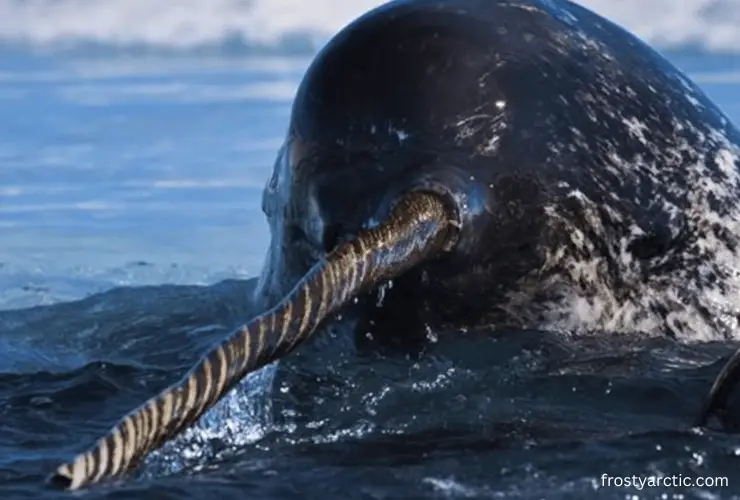No, narwhals are not dangerous. They are known for their unique tusks. Rather than for aggression, they use tusks for social interactions and mating displays. Narwhals are typically docile creatures and are not known to attack or pose a threat to humans.
They often avoid human contact and are known to be shy. In the wild, they primarily feed on fish and squid and do not have a diet that includes humans.
Narwhals, a species of whale primarily found in the Arctic Ocean and its coastal waters, engage in hunting for their sustenance. As carnivorous marine mammals, they rely on the consumption of other animals.
Notably, narwhals have a relatively limited diet and exhibit the intriguing characteristic of refraining from feeding during summer. Instead, they primarily feed during autumn and winter.
Let’s find out more interesting facts about these marine creatures!
Can Narwhals Kill Humans?

No, not at all. Narwhals are elusive creatures that seldom come into contact with humans. Whenever they sense human presence and feel disturbed, their instinct drives them to dive deep into the ocean. This causes their heart rate to slow down dangerously. However, these creatures are more likely to die in such interactions than we are.
Interesting Fact! These remarkable marine mammals exhibit physiological reactions reminiscent of an animal frozen in fear. Their heart rate, breathing, and metabolism slow down, resembling the response of a “deer in the headlights.”
However, narwhals take this freeze response to extraordinary levels. These creatures can reduce their heart rate to as low as three beats per minute for over 10 minutes, all while vigorously pushing themselves with their tails, reaching up to 25 strokes per minute during an escape dive. That’s shocking…Right?
Has A Narwhal Killed Anyone?
No. There have been no recorded incidents in which a human has been attacked or killed by a narwhal. Although these toothed whales possess a distinctive spiral tusk and exhibit a medium-sized physique, they do not pose a danger.
People who have travelled to the Arctic Sea and the Arctic Pole frequently share wonderful stories of their encounters with pods of bottlenose dolphins and narwhals.
Thus, it can be concluded that despite being whales and carnivorous by nature, these creatures exhibit a polite and gentle demeanor, posing no threat to humans.
Do Narwhals Kill with Their Horns (Tusks)?

No, narwhals do not use their horns (tusks) as spears, at least not in the traditional sense. Some scientists speculate that narwhals may emit fish-stunning acoustic waves using their tusks as a focusing device, although this theory is still under debate.
During mating season, male narwhals engage in modest tusk battles, although it appears to be more posturing than a full-fledged battle.
The narwhal tusk is not a hardened and calcified horn but rather an elongated tooth filled with dental nerves and pulp. Breaking a tusk would be excruciatingly painful and could lead to dangerous infections.
Frequently asked questions (FAQs)
Do female narwhals have a horn or tusk?
Female narwhals usually don’t have a horn or tusk. In contrast, male narwhals have tusks. While the tusk is predominantly found in male narwhals and tends to be longer compared to their female counterparts, some females may also develop a smaller tusk.
Are narwhals afraid of humans or nice to humans?
We can say that they are afraid of humans because they avoid human contact. But they could be more human-friendly as well. Whenever they come into human contact, they dive deep into the ocean. So, it means they are afraid of humans or maybe shy.
How big are narwhals compared to humans?
Narwhals are three times longer and four times heavier than the average American adult. On average, mature narwhals can reach 13 to 18 feet and weigh around 800 to 1600 kilograms. In comparison, the average height of an adult human in the USA is about 5 feet 9 inches, and the average weight is approximately 90 kilograms. So, narwhals are significantly larger than humans. Now you can imagine how big they are as compared to humans!
Do narwhals bite?
Narwhals are not known for biting humans. They primarily feed on fish and squid and tend to avoid direct interactions with humans. However, like all wild animals, they may defend themselves if they feel threatened or cornered. It’s essential to maintain a safe distance and respect their natural behaviors when observing them in the wild to ensure both human safety and the well-being of these magnificent creatures.
Conclusion
So, narwhals, with their unique tusks and distinctive behaviors, are not dangerous to humans. They typically avoid human contact and are known to be docile creatures. While their tusks have been the subject of various theories, they are not used as spears but rather serve as sensory organs.
Males utilize their tusks for competition and attracting mates, akin to the ostentatious displays seen in other animals. Despite their classification as a species of Least Concern, narwhals face significant threats due to human activities, such as climate change and habitat destruction.
Conserving and protecting narwhals is crucial to ensuring their survival for future generations. Understanding and appreciating these remarkable marine mammals contributes to our knowledge of the natural world.



4 thoughts on “Are Narwhals Dangerous? Do They Attack Human?”